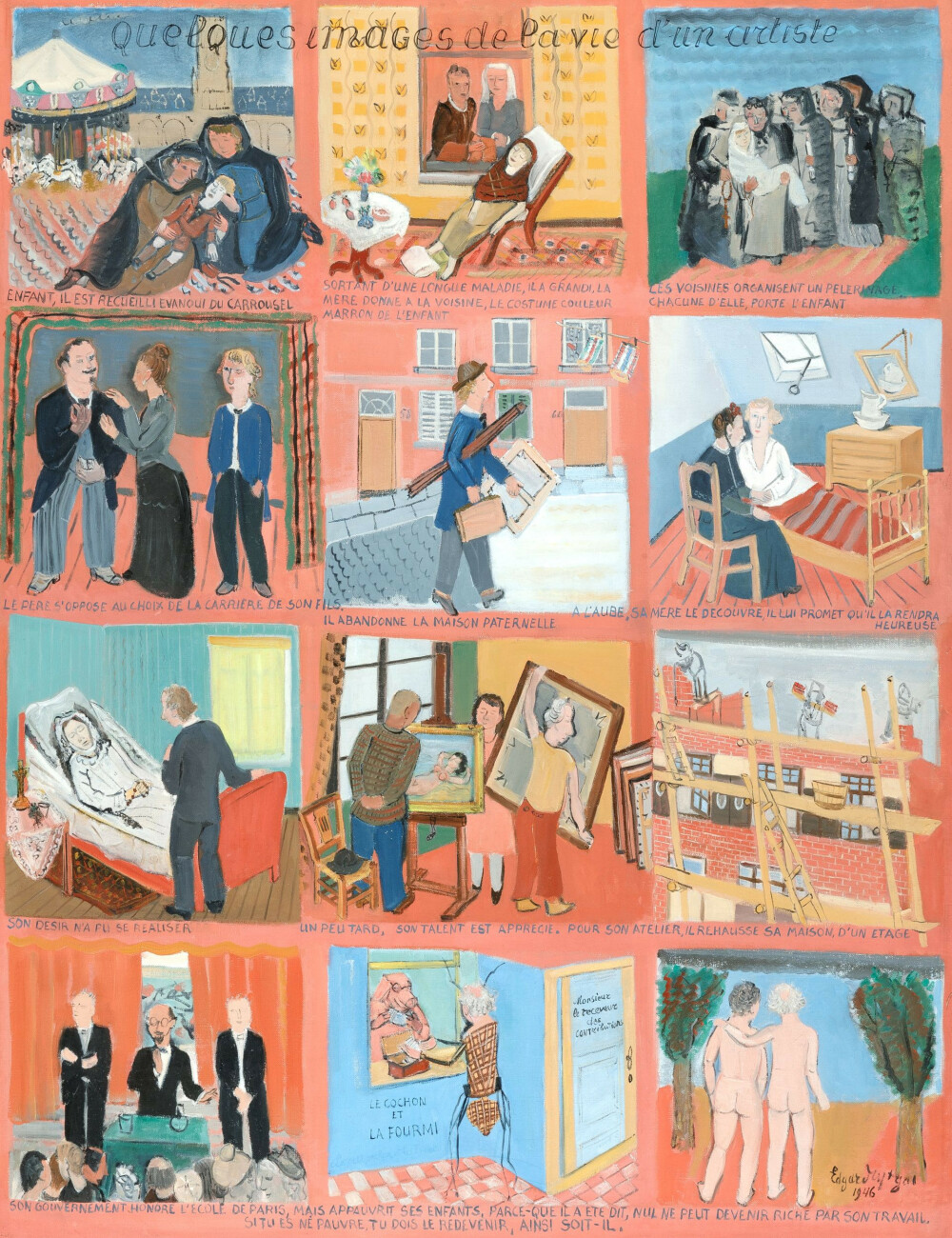Lot 252
Edgard Tytgat
Belgium / 1879 - 1957
Some images from the life of an artist - Quelques images de la vie d'un artiste (1946)
Details
Oil on canvas
Sig. 1946 with title and on the reverse "Sept. 1946" with title - Exhibition labels on the reverse
116 x 89 cm
After the end of the war, Tytgat had to pay a considerable sum, almost all of his savings, to the tax authorities. For a long time, the artist was very impressed by this claim. In this series of images, he recounts the suffering of his childhood and his career as an artist, including his first successes. In the penultimate image, Tytgat, represented as an ant, gives his savings to the taxman, represented as a huge pig. In the last image, he retraces his steps, naked, together with his wife. The subjects of three prints from this ensemble were reproduced by Tytgat in watercolours, which served as illustrations for the childhood and youth memories written by the artist in 1956.
Provenance
- coll. Tony Herbert, Kortrijk
Exhibition
- "Kunst van Heden: Salon 1947" Feestzaal, Antwerp 1947, cat. no. 169
"Edgard Tytgat" Hooghuis, Bosvoorde 1948, no. 32
"Facetten van Hedendaagse Schilderkunst" Gemeentemuseum, Den Haag 1949, cat. no. 119
"XXVIIIe Salon: Retrospectieve Dufy - Tytgat" Koninklijke Kunst- en Letterkring, Charleroi 1954 cat. no. 99
"Vlaams expressionisme" Hal van de Universiteit, Leuven 1955, cat. no. 55
"Verzameling Tony Herbert" Ghent, Hasselt, Oostende, Den Haag, Groningen, Charleroi, Breda 1957/1958 cat. no. 29, ill.
"Permeke en Tytgat" MSK, Kortrijk 1962, no. 21 ill.
"Vier Vlaamse Expressionisten" Almelo 1962, Amersfoort 1963, cat. no. 31, ill.
"Art belge contemporain" Stuttgart
"Ensor tot Permeke" London
"Edgard Tytgat, Herinnering aan een geliefd venster" Museum M, Leuven 2017, p. 51 ill. & p. 34 image of the artist with this work
Literature
- Nieuwe Gids, 14-7-1955, ill.
"Verzameling Tony Herbert" 1957, no. 29 ill.
"Edgard Tytgat. Beschrijvende catalogus van zijn geschilderde oeuvre, opgemaakt met de medewerking van Mevrouw Gisèle Ollinger-Zinque" Albert Dasnoy, Laconti S.A., Brussels 1965, cat. no. 458
"Collectie Tony Herbert" Deurle 2011, p. 48 ill.
Lot essay
Edgard Tytgat, visual storyteller
We get on on the merry-go-round. It barely gets started when I pass out. Everyone in turmoil. Women in black hooded cloaks carry me home. My brother follows us, shivering and weeping.
(Edgard Tytgat, Memories of Childhood and Youth, ca. 1950)
This is how Edgard Tytgat's first tale goes. A traumatic experience that haunts him as a child and enriches him as an artist. At this precise moment, the seeds of his painting career were sown. It is therefore the first scene of this masterly canvas "Quelques images de la vie d'un artiste". Tygat chronologically depicts his life as an artist, his successes and misfortunes, his dreams and nightmares.
The top row shows Tytgat's troubled childhood. Then in the second row we see his quest as an artist and his detachment from the parental home. His career takes off, while at the bottom row it becomes clear that after the top, decline follows. The autobiographical scenes also refer to other paintings by Tytgat, such as in the middle of the third row: "Ministerial visit", which he made in 1934.
The penultimate image depicts Tytgat as an ant, who gives his savings to the taxman, depicted as a giant pig. After the war, Tytgat owed a large sum, almost all of his savings, to the tax authorities. A claim that marked the artist for a long time. In the last image, he resumes his journey, naked and destitute, with his beloved wife.
Tytgat takes us on a visual journey through his repertory. In twelve scenes he tells the story of his life, which he subtly decorates with fable, fantasy, myth and humor. Delineated scenes form a linear narrative that is depicted in one single image like a comic strip. It is a seemingly simplistic way of rendering, after a medieval example, but Tytgat is inventive and ingenious. With a web of references, autobiographical elements, stories, fantasy and titles, he weaves a monumental story complex in which images and meanings fully unfold in their mutual relationship.

